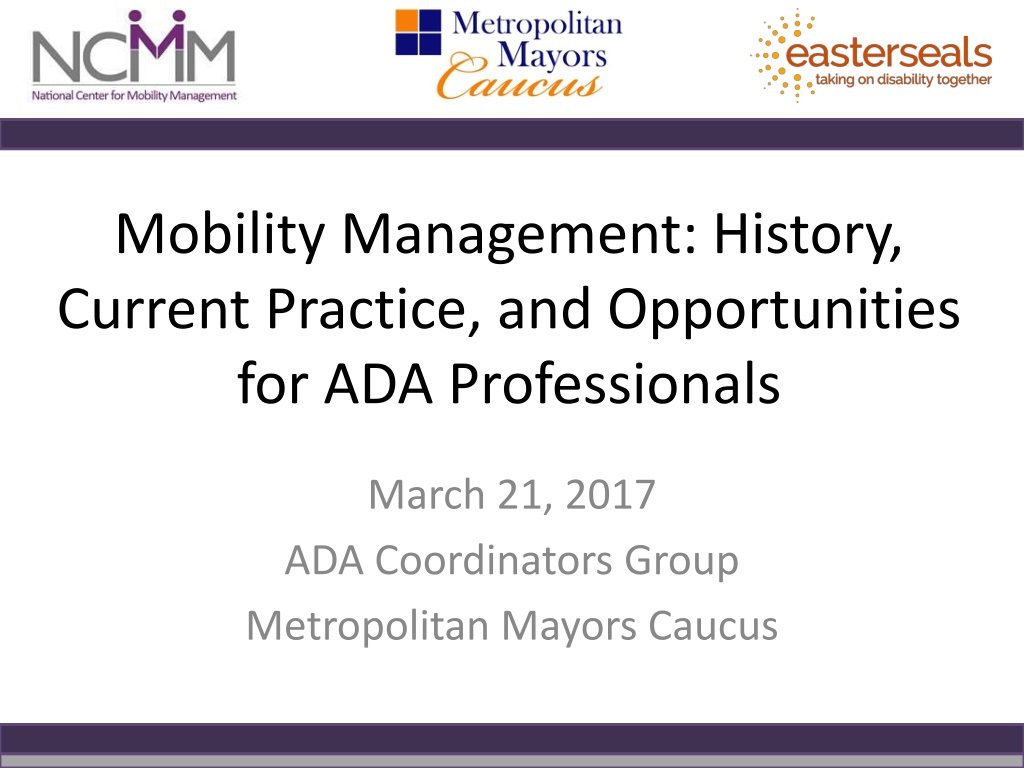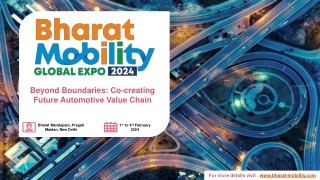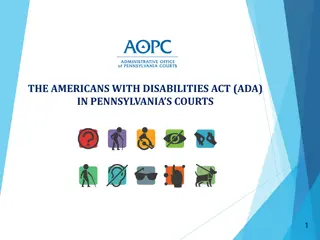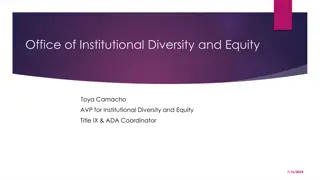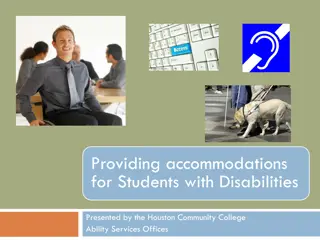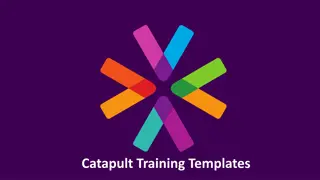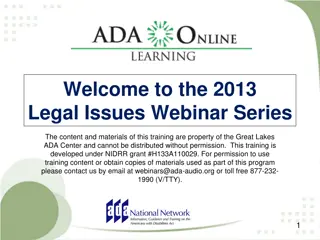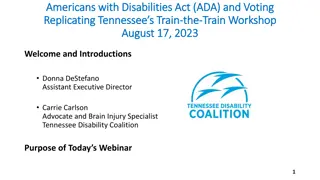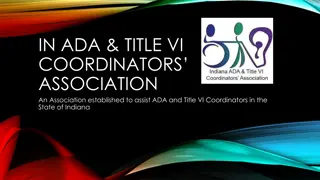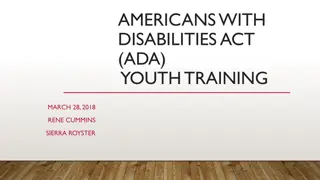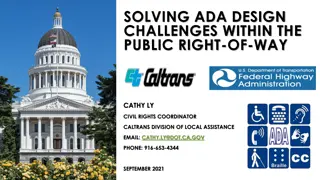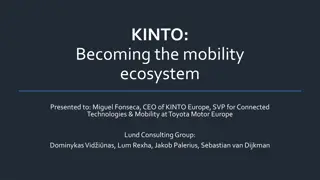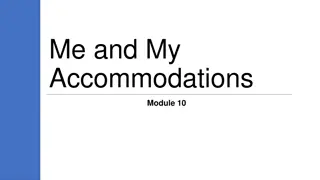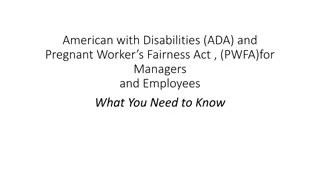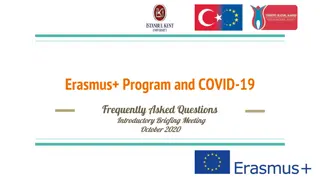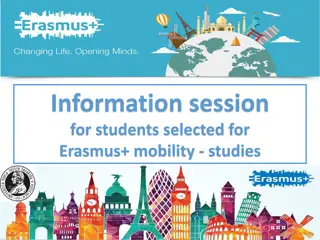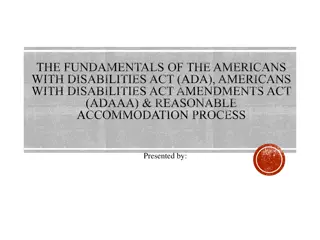Understanding Mobility Management for ADA Professionals
Explore the history, current practices, and opportunities in mobility management for ADA professionals. Learn about the National Center for Mobility Management (NCMM), its mission, and the role of mobility managers in empowering individuals for independent living. Discover how mobility management strategies contribute to health, economic vitality, and community advancement.
- Mobility Management
- ADA Professionals
- National Center
- Transportation Strategies
- Community Empowerment
Download Presentation

Please find below an Image/Link to download the presentation.
The content on the website is provided AS IS for your information and personal use only. It may not be sold, licensed, or shared on other websites without obtaining consent from the author. Download presentation by click this link. If you encounter any issues during the download, it is possible that the publisher has removed the file from their server.
E N D
Presentation Transcript
Mobility Management: History, Current Practice, and Opportunities for ADA Professionals March 21, 2017 ADA Coordinators Group Metropolitan Mayors Caucus
Todays Topics Introduction NCMM and FTA NCMM Mission and History Introduction to Mobility Management What is Mobility Management? Who is a Mobility Manager? Mobility Management Process National Trends and Case Studies Q&A
National Center for Mobility Management We Can Help You Make Connections The mission of the National Center for Mobility Management (NCMM) is to facilitate communities to adopt transportation strategies and mobility options that empower people to live independently and advance health, economic vitality, self- sufficiency, and community. National Center for Mobility Management
About the NCMM National technical assistance center Launched in early 2013 Jointly operated by three national organizations: Easterseals American Public Transportation Association Community Transportation Association of America Cooperative Agreement with the Federal Transit Administration, USDOT
Introduction to Mobility Management What is Mobility Management? Innovation in transportation service and coordination Local and regional solutions to fit community need Assist those that face transportation challenges Youth People with disabilities Aging populations English language learners Those with limited income Networked services to provide solutions to those above
Introduction to Mobility Management History of Mobility Management Transportation services were offered in an era of: Smaller communities Less sprawl Consumers with predictable needs Transportation/transit success measured by: Efficiency, effectiveness and overall productivity Transportation as product, not solution
Introduction to Mobility Management History of Mobility Management, continued In 2003, a shift in perspective Quality of customer experience Operational issues are still important, but subordinate Quality is more important than territorial concerns of equipment and service The last decade has seen change, but process ongoing
Introduction to Mobility Management History of Mobility Management, continued In 2003, a shift in perspective Quality of customer experience Operational issues are still important, but subordinate Quality is more important than territorial concerns of equipment and service The last decade has seen change, but process ongoing
Mobility Management: Coordination of People and Transportation Providers Mobility Managers Work In Non-profits, AAAs, Community Action Agencies, Aging & Disability Resource Centers, Schools, Higher ED, Governmental agencies, Workforce Development, Hospitals, Fed Qualified Health Centers, Food & Nutrition Programs, Faith-Based Service Organizations Human Services Transit- Mobility providers Public fixed route providers, private agencies & providers NEMT providers Planning organizations
Introduction to Mobility Management Who is a Mobility Manager? A problem solver An advocate for those who need transportation A facilitator of groups A teacher, communicator and cheerleader
Introduction to Mobility Management What does a mobility manager do? Builds networks Transportation providers and planners Workforce development and educational agencies Healthcare agencies Elected officials Understands the population they re advocating for Environmental scan, inclusive planning, and solicitation of feedback
1. Begins with a full understanding of customers transportation needs 2. Brainstorms a potential solution that matches this understanding with the range of available or possible services 5. Ensures customers can provide feedback on the solution so it remains relevant and useful 3. Engages one or more partners in providing the solution in a coordinated manner 4. Empowers customers to connect to the solution
Understanding Individuals Needs Individual and group discussions Family information Information from agencies/organizations The goal: Formalize the knowledge you collect about those you re working to find solutions for Makes you a better advocate, solutions more reachable
Individualized Transportation Needs Assessment Tool Document available to you here Six steps: Current transportation options Where and when? Mobility considerations ADA eligibility Community transportation options Ability to pay?
Step 1: Current transportation options Private vehicle Shared rides Public transportation services
Step 2: Trip Needs and Details Type of destination? Purpose of trip impacts choice of service from available options Helps prioritize within community or volunteer programs Record all details Who will be traveling? Time?
Step 3: Considerations for Mobility Basic traveling skills Functional, sensory, and intellectual or cognitive considerations Disabilities that are not apparent Culture, language and other personal issues
Step 4: Eligibility for Paratransit Services Eligibility for ADA-complementary paratransit services Type of appropriate transportation services Shared? Alternative modes?
Step 5: Applicable Transportation Options Applicable routes Cost Accessibility Type of service Advance reservation requirements
Step 6: Ability to Pay Current expenditures on transportation Amount individual is able to comfortably budget Amount of additional funds necessary Resources to help pay for transportation Listen to their concerns, goals, and ability to obtain additional resources
Assessing Groups of Riders Destination Origin Agency/organization Built in network to utilize Source of education on your community and neighbor needs
Working With Specific Populations People with disabilities Job seekers and limited income Medical trips Older adults Military veterans Other Social groups English language learners
People with Disabilities Disability intersects with other populations Disability status may come with funding/assistance Some facts: In 2003, half a million were homebound In 2012, 34% employment v. 83% w/o disability Not all of this is owed to transportation, but it plays a role
The ADA and Transportation Passed 1990, amended in 2008 Designed to: Give civil rights protections to and eliminate discrimination against individuals with disabilities Eliminate barriers those with disabilities face in the public arena Dept. of Justice ADA website: www.ada.gov
The ADA and Transportation Passengers Rights Use any publicly funded bus or rail system Expect reasonable accommodations Receive complementary paratransit service if 1 of 3 eligibility categories are met Finally right to file complaints if any of the above isn t adhered to
Title VI Transportation Implications Civil Rights Act of 1964 Based on race, color and national origin Most recent circular is 4710.1 Not just service, but planning participation too What was missing from ADA? More on this later!
Mobility Funding for People with Disabilities FAST Act 5310 Enhanced Mobility of Seniors & Individuals with Disabilities 55% capital/45% operating, marketing and alternative transportation services 80% federal/20% local match Social Security Administration Programs Plan for Self Sufficiency (PASS), Impairment-Related Work Expense (IRWE), Blind Work Expenses, etc
Service Strategies for People with Disabilities Fixed-route services (w/ travel instruction) Demand-response/subscription services Local disability services agencies Nonprofit organizations Volunteers, church groups, etc. Private providers Ridesharing
Travel Training Continuum Travel training may be necessary (continuum) Written guide On-line video instruction In-person/on-site orientation Group intro Bus buddy system Intensive Travel Training
Environmental Scan and Network Building Objectives Outline different customer groups mobility managers interact with Introduce concept of environmental scan Needs of community Available services Introduce individual and community assessment tools and their potential use scenarios
Who are your customers? Individual riders and their caregivers Particular groups of individuals General public Rural communities People with disabilities Aging populations Agencies and transportation providers Your mobility management network
Referrals from Agencies/Organizations Referral protocol Case managers do assessment described earlier Share results with mobility manager Mobility manager assists in problem solving, connections Formal system Based on data from missed appointments, where available
Referrals from Agencies/Organizations Referral protocol Case managers do assessment described earlier Share results with mobility manager Mobility manager assists in problem solving, connections Formal system Based on data from missed appointments, where available Important to consider solution that respects privacy
Agencies/Organizations as Customers Human service/workforce development agency Share information on services Process for collecting data on unmet needs Reducing customer missed/late appointments Businesses and employers Nonprofit organizations
Mobility Management Network as Customer Members of your network are you customer How does transportation fit into their work? What is their capacity for focus on transportation? Partner in education? Their concerns for their clients Desire to see client/individual needs met Standards adhered to
National Trends TNC/Shared-Use Pilot Programs Expanding Statewide Networks Inclusive Planning
National Trends TNC/Shared Use Lyft pilot programs Brookdale Senior Living Solutions Limited pilot Use of service without app via concierge Charges directly to resident bill Pilot came about through direct resident involvement What needs are unmet, where is opportunity? Blue Cross Blue Shield Pharmacy connections in transportation deserts in Chicago Appointment rides in certain areas of Pittsburgh Still in development
National Trends TNC/Shared Use Key questions remain Equity in practice Local constituency/ability to enforce Strategies for adoption Seek all partners Transportation not limited to government entities
National Trends Expanding Networks Ohio Mobility Management Program Similar to other state networks Wisconsin Maine Michigan Not just for transportation officials! Area Agencies on Aging, Disability Rights Groups
National Trends Expanding Networks What could this look like in Chicago region? Connections to all RTA services Volunteer and Human Service Connections Across muni borders Share resources, share benefits Barriers to cooperation?
National Trends Inclusive Planning Administration for Community Living Transit Planning 4 All 25 Demonstration Programs Not just about compliance OSU Nisonger Center Personal mobility technology People with cognitive disabilities were focus Inclusive Planning Design *from* and not *for*
Tap into Resources National Center for Mobility Management National Aging and Disability Transportation Center National Rural Transit Assistance Program ACL Transit Planning 4 All
Take Advantage of Our Resources Webinars, Newsletters, Products Mobility Management & Information Practices Database (MMIP) Technical Assistance ask your liaison Link to Liaisons
